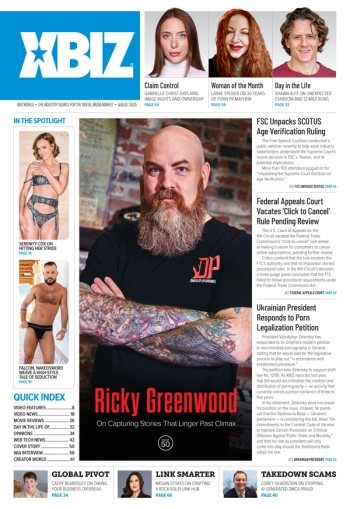Fetish attire has come a long way since the 1960s, 1970s and 1980s. In those days, fetish attire was much more underground than it is now. But with BDSM depictions showing up in everything from beer commercials to sitcoms to telenovelas these days, fetish fashions are much more ubiquitous than they were 30, 40 or 50 years ago — and with that ubiquity has come considerable diversification.
To understand how much fetish attire has evolved and diversified over the years, one needs to look back at a time when BDSM was still taboo and fetish images were still a rarity in mainstream pop culture. Fetish attire made rare appearances on mainstream television in the 1960s with Emma Peel and Cathy Gale on “The Avengers” and Catwoman on “Batman;” all of those characters wore tight black leather in a dominatrix-like way. And when the heavy metal band Judas Priest was at its commercial peak in the 1970s and 1980s, lead singer Rob Halford often favored the attire of gay BDSM leathermen. If one encountered the occasional fetish image in mainstream pop culture before the 1990s, it was usually black leather.
Most of our garments are made of latex, whereas most of our gear — such as restraints, collars, arm binders, cock rings, etc. — are made of leather. -Layla Ross, Stockroom.com
The 1990s were a major turning point for fetish attire. BDSM — or at least a lighter, softer version of it — invaded mainstream music, films and television in a big way during that decade, and fetish fashion went from being dominated by black leather to being a diverse combination of leather, latex, spandex and PVC. And fetish fashion became popular not only in the BDSM scene, but outside of it as well. A female fetish model can also be a dominatrix, or she might have little or no interest in BDSM.
Asked to comment on the ways in which fetish fashion evolved and diversified after the 1980s, Joel Tucker (who founded Stockroom, a major provider of BDSM gear and fetish attire, in 1987) responded: “The first thing that comes to mind for me is the shift from black leather and everything being on the dark, serious side to latex and other materials and vibrant colors, as well as more playful, humorous or feminine elements. Fetish attire has also become a scene/interest unto itself more than it was in the past. It also seems to be a bit more social and less sexual; wearing the attire isn’t necessarily an indicator of a strong BDSM interest.”
Black leather didn’t disappear from fetish attire after the 1980s. Gay leathermen still assert their “leather pride,” and many pro-dommes still love their leather. But these days, a domme’s corsets, thigh-high stiletto domination boots, long opera gloves and catsuits are likely to be made of latex instead.
Layla Ross, Stockroom’s distribution and packaging director, noted that in 1980s, there was an assumption “that if you were into BDSM, you were automatically into wearing leather, regardless of your kink.” But Ross quickly added that latex now dominates Stockroom’s fetish attire offerings. “Most of our garments are made of latex, whereas most of our gear — such as restraints, collars, arm binders, cock rings, etc. — are made of leather. So, it is safe to say that a larger portion of our clothing is going to be made of latex rather than leather.”
The Baroness, a well-known clothing designer who owns a store in New York City’s East Village and has been designing latex fashions since 1995, observed that the BDSM scene had much stricter dress codes in the 1970s and 1980s than it does now — and the black leather attire that tops (dominants) wore in those days had a “strict” quality. “When I was coming into the scene,” The Baroness recalled, “there were expectations about what a top should wear and what a bottom should wear. Generally, the common thing was that submissives tended to wear less clothing, while masters tended to wear more clothing. The look of tops was tight, strong and in control. But nowadays, people will look at the fashions and say, ‘Oh, this is cool. I’ll just wear this.’”
As The Baroness sees it, latex can convey a very different message from leather. “Leather looks tough, whereas latex doesn’t necessarily make you look tough,” The Baroness explained. “Latex can make you look like you’re weird or make you look like you’re really frightening. Latex can look tough, but generally, I don’t think of latex as a tough look. Latex looks intriguing. It can give you a feeling of, ‘I don’t know what to expect from this.’”
The Baroness added that some of the latex fetish attire she is seeing on women in 2013 has a much more sex kitten-ish quality than the “tough” leather attire of the 1960s, 1970s and 1980s. “Nowadays, you will see a corset that doesn’t look strict and frightening,” The Baroness observed. “It looks more like a Little Bo Peep corset with little bows and frills, or a corset that has a burlesque look or a show biz look. It’s still fetish, but it’s more clothing as fun as opposed to clothing that’s strictly fetish.”
Another big change in fetish attire is the variety of colors that are now available. Black used to be the official color of fetish fashion, but now, fetish attire comes in a variety of colors. Ross pointed out that Stockroom now offers fetish attire in 39 different colors, noting: “Once the Internet hit, latex fashion became more accessible and evolved from being only worn by people into BDSM to being worn as fashion by people who were not even into BDSM. It also started leaning towards more feminine styles, which are younger, bolder and available in almost any color combination you desire.”
The Baroness doesn’t see fetish fashion becoming any less diverse in the future. The classic leather attire, she said, will be viewed as only one of the many fetish options that are available. “I don’t think the all-leather look will completely die out because it’s so iconic,” The Baroness asserted. “There will still be the stern leather dominatrix look, which is classic and iconic. But times do change. A lot of the old school people want it the old way, but a lot of the new people are interpreting fetish a completely different way.”







